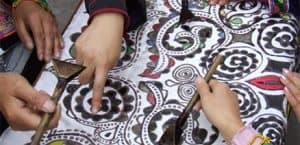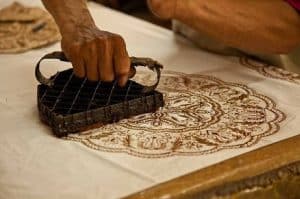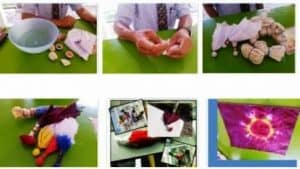Other than having many complex traditions and cultures, Indonesia is known for its Batik. Batik is a famous fabric that originated from Indonesia. The fabric holds strong value of arts as well as cultural influences. Some regions may also instil their philosophy into making the batik patterns on the fabric. Batik was officiated by the UNESCO as a masterpiece and an important heritage to humanity. It is truly a valuable Indonesian heritage. But to fully appreciate the beauty of batik, one needs to know how the fabric is made. This article will give you all the Types of Batik Techniques in making the batik fabric.
Read more:
1. Canting Tulis
 This first technique of batik is very old but also highly traditional. For this particular technique, people use canting. Canting is like a small container made with copper and wood. There is a small snout at the end of canting to release the hot wax. A person will draw using the canting very carefully.
This first technique of batik is very old but also highly traditional. For this particular technique, people use canting. Canting is like a small container made with copper and wood. There is a small snout at the end of canting to release the hot wax. A person will draw using the canting very carefully.
There are so many interesting patterns that people create using canting. When the drawing has finished, the fabric is dipped inside a coloured dye around four times.
This technique needs a person with high art skill due to its complexity. It may take up a year to create batik through this method. The long process reminds us of another valuable Indonesian fabric which is the Indonesian ikat fabric that can also take years to create.
Here are the advantages for using Canting Tulis in making batik:
- Each batik created using the method is unique. No two patterns are the same.
- The pattern on the batik is detailed and complex which adds more value.
- On the batik, there is the initial of the artist who made the patterns on the fabric.
2. Printing
 Printing is another technique in making batik. In fact, it has become a popular option in some of the commercial batik industry. The method is first introduced to the mass during the 70s. A printing machine is used for this technique. The patterns are already determined using computer or other machines.
Printing is another technique in making batik. In fact, it has become a popular option in some of the commercial batik industry. The method is first introduced to the mass during the 70s. A printing machine is used for this technique. The patterns are already determined using computer or other machines.
The printing machine will just print the patterns out on the fabric. Unlike the previous technique, this method require less artisanal ability because it heavily relies on machinery to do its job.
The batik fabric from the method is usually sold in the form of meters. Other than that, batik fabric from printing can be identified by the lack of pattern on the underside of the fabric.
Also read: Traditional Clothes in Indonesia
Below are some of the advantages for using Printing in making batik:
- Quicker production means less time is needed to produce one batik fabric.
- Mass production is very possible so more batik fabric can get into the public market.
- The patterns on the fabric are still very clear and detailed especially with the continuous advancement of machinery.
3. Cap
 Another technique for batik is Cap. Cap works in a similar way as a stamp. The tool used for the technique has a very, very flat base. Moreover, it is also thin. The tool is different from Canting Tulis. To make this technique to work, a person would need a stove. The stove functions to melt the wax for the stamp.
Another technique for batik is Cap. Cap works in a similar way as a stamp. The tool used for the technique has a very, very flat base. Moreover, it is also thin. The tool is different from Canting Tulis. To make this technique to work, a person would need a stove. The stove functions to melt the wax for the stamp.
The wax will cover all the surface area on the stamp. The stamp is then carefully pressed on to the fabric. One needs to have full focus as the stamp has to end up neat.
Some of the advantages for this technique is listed below:
- Using the Cap technique, more area on the fabric can get the same coverage from the wax.
- It is a quick technique to finish a batik fabric. It is even possible to create a wonderful batik fabric within a day by using this method.
- Due to the less complexities in the making for the batik fabric, the price is relatively cheaper for the public consumption but the fabric is still one of the most beautiful fabric in Indonesia.
4. Jumputan
 This next technique is the tie-dye technique. In Indonesia, the method is more known as Jumputan or Celup Ikat. This technique makes it fairly easy to create batik patterns on a piece of fabric.
This next technique is the tie-dye technique. In Indonesia, the method is more known as Jumputan or Celup Ikat. This technique makes it fairly easy to create batik patterns on a piece of fabric.
The fabric is first tied and then dipped into coloured liquid. When the tied fabric is opened, the batik pattern is revealed.
Also read: Indonesia Cotton Fabric
Here are some advantages from the Jumputan technique:
- The batik fabric is sold at a very cheap price because the process in making the batik fabric is very easy and not time consuming.
- This method can serves as a teaching method to young children. This way they can learn about making batik.
- The patterns as well as the colours on the fabric are very distinct, unique, colourful and vibrant.
5. Colet
 This last technique in making batik is Colet. This method is similar to painting the batik pattern on the fabric. The person making the fabric will spread out some colouring on the fabric using a brush. Then he or she will draw batik patterns on top of the fabric.
This last technique in making batik is Colet. This method is similar to painting the batik pattern on the fabric. The person making the fabric will spread out some colouring on the fabric using a brush. Then he or she will draw batik patterns on top of the fabric.
Similar to Canting Tulis, this technique needs skilful people to paint on the fabric. The patterns must be beautiful. The more complex and detailed the patterns are, the more expensive the fabric becomes. You can find this technique in making Javanese batik fabric.
The advantages of the Colet technique in making batik are as follows:
- There is high value in the artistry because the technique is manually done by people.
- The patterns on the fabric are always different on each fabric because not the same person is making it.
- The colours of the patterns on the batik fabric is very vibrant.
Read more: Indigenous Tribes in Indonesia
Beside what I explain above, here I give you visual tutorial about one of batik technique called “Jumputan” as follows:
The difficulty level of creating batik fabric ranges widely using these techniques. However, these methods should make you appreciate the craftsmanship of the people involved in painting the patterns on the fabric. Making batik fabric takes time, heart and a skill that is truly unique in Indonesia.
